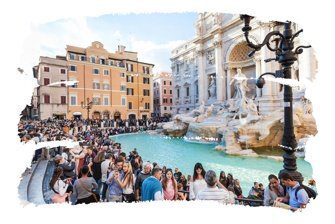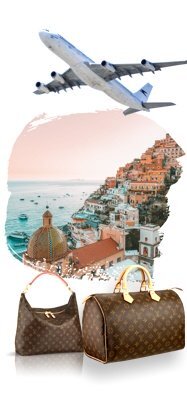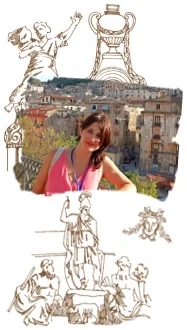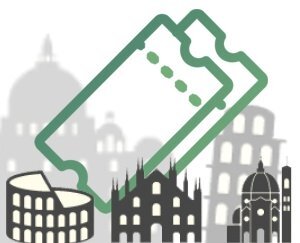Let’s visit Leonardo Da Vinci’s Last Supper?
In Lombardy, among the seven sites recognized as “World Heritage Sites” by UNESCO, we find Milan, with the entire Dominican Church and Convent of Santa Maria delle Grazie, plus: one of the most famous paintings in the world called the Last Supper, by Leonardo da Vinci, two complete masterpieces at world level. Stay with us and together we will visit the Leonardo Da Vinc: The Last Supper in Milan. Here at Your Travel to Italy with Ana Patricia you make the trip of your dreams!!! ALSO: see our “Accommodation in Italy – Tips for your holidays!”
A touch of history…
Leonardo painted the Last Supper on a wall in the lunchroom of the convent of Santa Maria delle Grazie for Ludovico, the Moro, from 1494 to 1497. Although it was a painting on the wall, the artist did not give up to the traditional resistant technique of painting, which requires a quick application of color on the plaster that is still wet. He tested a method that allowed him to intervene in the dry plaster and, therefore, to be able to go back to more of the work taking care of every detail of it. Unfortunately Leonardo’s perceptions were wrong and very early, the painting started to deteriorate.
Over the centuries, many restorations followed to try to save the masterpiece. In 1999, after twenty years of work, the last conservative intervention was completed! Thanks to the removal of many repaints, they brought to light what was left of the original applications. This work is considered the most famous representation of the Last Supper, masterpiece of Leonardo Da Vinci and the Italian Renaissance.
A Request from Ludovico Sforza, Duke of Milan
The Last Supper was entrusted to Leonardo by Ludovico Sforza, Duke of Milan, in a project to beautify the convent and the church of Santa Maria delle Grazie. Ludovico Sforza kept this project above all the other because, here, the Prince intended to establish his grave. Leonardo da Vinci created a praiseworthy example of the “new perspective”, inaugurated in Florentine art, Leonardo’s great idea was to open the main wall of the refectory with the illusion of a spacious chamber with a caisson ceiling.
What does the work represent?
The work represents the Last Supper and in particular, the very moment when Jesus announces that one of the apostles will betray him. It is very indicative of the fact that Leonardo chose to paint the Last Supper right in the dining room, the place where the religious were having lunch and dinner every day. Thus, the presence of this work, in the midst of the daily gestures of lunch and supper, was a constant call to the monks, and showed that the life of the religious community is an extension of the life of Christ and the apostles.
Leonardo da Vinci’s masterpiece is truly innovative, whether from the point of view of composition or the subjects’ surrender. The theme of the Last Supper had been treated by many artists, but always in an austere and fixed way: the poses of the Apostles were rigid and stylized.
About the Apostles
In Leonardo’s work, on the other hand, the apostles are placed in a single plan and are not arranged in front or behind the table, but all on the same side. They are divided into groups of three and, through these patterns of union and separation, are involved in a kind of communication, expressed also by the psychologically studied reactions of their faces. Behind the characters open a wide and analyzed environment according to the strictest rules of symmetry and perspective.
Since the scene was represented on the wall of a convent in a cenacle, Leonardo da Vinci was very careful to create a fictitious space that would be in tune with the real one in order to create an illusionist and intimate connection between the world of painting and the monastery. The strong scenographic impact is defined with other elements of composition, such as the dimensional scale of the figures (larger than the actual figure) and the strong dramatic intensity of the faces of the apostles.
The realism
“Truly, I tell you, one of you will betray me.” This is one of the most intense and touching passages of the New Testament, and this is exactly the moment that Leonardo da Vinci chose to represent. The realism of the representation makes such a moment even more particular; the words, in fact, provoke an infinite variety of gestures, movements, and facial expressions, all dictated by the apostles’ different emotional reaction.
In this work Leonardo represents the emotions of the protagonists of history, Jesus and the apostles. For the painter it was very important to illustrate the “movements of the mood”, in fact: in his Treatise on Painting he wrote that the excellent painter must know how to represent not only the exterior aspect of man, but also his thoughts, his emotions; the first thing is not difficult to do, but the second is a challenge, because thoughts and emotions must be represented through gestures and attitudes.
Dramatic Moment
For this reason, Leonardo decides to represent the next moment after Jesus’ words: “One of you will betray me”. It is the most dramatic moment of the Last Supper: each apostle asks himself, and asks others, who could be the traitor. Leonardo concentrates on the effect that Jesus’ words have on the apostles, on their reactions: because of this he changes the way of representing the scene in relation to the previous artists.
Leonardo makes us understand the character of each apostle and how each of them reacts to the same emotional situation in a different way, according to their different character: it is the presentation of his theory of mood movements. Leonardo’s painting represents a “catalogue” of emotions transmitted through gestures and expressions, in this painting words are useless, you only need to look at this masterpiece of Leonardo that constitute one of the most noted and studied wonders in the world.
Anecdotes and curiosities
The monks had opened a door to reach the kitchen first, knocking down part of the painting, right where Christ’s feet would be. Originally, according to Leonardo’s drawing, the representation of the apostles at the Last Supper had to be different, that is, with the apostles along the table as so many separate units. The artist perceived that the painting, thus conceived, nevertheless gave a fragmented and abstract idea of reality and therefore preferred to unite the twelve apostles around the figure of Christ, in four large different groups, but united by an impetus of reaction to the words and gesture of the Savior. To visit the Last Supper of Da Vinci means to feel the emotion before such greatness.
Tickets and Information
For all categories of tickets a reservation is required. Entry to the Last Supper is permitted only on the day and according to the time of the reservation. If this is not possible for various reasons, entry is therefore permitted on the following days, depending on availability, even beyond the validity of the ticket. The ticket is picked up near the ticket office located at the museum entrance, and you must present yourself twenty minutes before the visit, so that you are not subject to the penalty of losing your reservation; be sure to present, also, your reservation code. Buy at the official website or if you prefer a English language website see the links below without purchase obligation.
Timetables to Visit
Visiting hours to the Last Supper of Da Vinci: the protection of Leonardo’s masterpiece requires optimal environmental conditions, obtained through air treatment and with particular procedures for visitor access, received in groups of twenty. Because of its characteristics and the place where it was created, the Last Supper is difficult to visit. Only small groups are received and only in a few days of the week, so the reservation is necessary. The online reservation is recommended.
The schedules are as follows
– Tuesday to Sunday, from 08:15 to 19:00 (last entry at 18:45).
– Closed on Mondays, January 1st, May 1st and December 25th.
– Visiting shifts last fifteen minutes, a maximum number of 30 people at a time are allowed.
– To visit the Last Supper it is mandatory to book the visit.
Remember that this monument is one of the most difficult to get tickets, so it is recommended to book, at least, 3 months in advance, O.K.!?
How to get to the Last Supper of Leonardo da Vinci?
The Last Supper of Santa Maria delle Grazie is located in Piazza Santa Maria delle Grazie, n° 2, in Corso Magenta, Milan. Milan is one of the cities easily accessible by any trasnport you choose. If you are in Milan, just go to the Church of Santa Maria delle Grazie as follows: take the MM1 (metro) or the MM2 (metro) and get off in Cadorna Station, then a few minutes walking, take the tram of lines 20 and/or 24, and then take the bus ATM 18. Or if you prefer, even simpler with a taxi or a Transfer from your hotel! – Click here without purchase obligation for a quotation!
Conclusion
The Last Supper is a painted poem! Of an impressive beauty, it is a real gift left by Leonardo Da Vinci to all mankind. Sensitive, elegant, exciting and impressive, the work is unique and really magnificent! You’re going to love it! Visit the Last Supper with an English speaking guide, she will know how to fascinate you and give you this unique and memorable tour.
An Extra Help for your Trip
The best content from Your Travel to Italy!
Learn more about our tours in Italy right now!
- What to visit in Italy in 10 days?
- The ten must-see places in Tuscany?
- The best tips to save on your trip to Italy?
- What are the 10 most visited cities in southern Italy?
- Airports in Italy? How to get to your hotel? (Venice, Milan, Rome, Florence)
- What to do in 1/2/3/4 days in the main Italian cities?
- The best tips on food in Italy (wines, typical food, enogastronomy tours)
- How to get from Fiumicino Airport to Rome downtown?
- Your Travel to Italy: 10 tips for traveling through Italy!
Best regards from Italy






 Save money!
Save money!